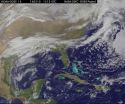(Press-News.org) GPS technology has broadly advanced science and society's ability to pinpoint precise information, from driving directions to tracking ground motions during earthquakes. A new technique led by a researcher at Scripps Institution of Oceanography at UC San Diego stands to improve weather models and hurricane forecasting by detecting precise conditions in the atmosphere through a new GPS system aboard airplanes.
The first demonstration of the technique, detailed in the journal Geophysical Research Letters (GRL), is pushing the project's leaders toward a goal of broadly implementing the technology in the near future on commercial aircraft.
Current measurement systems that use GPS satellite signals as a source to probe the atmosphere rely on GPS receivers that are fixed to ground and can't measure over the ocean, or they rely on GPS receivers that are also on satellites that are expensive to launch and only occasionally measure in regions near storms. The new system, led by Scripps Institution of Oceanography geophysicist Jennifer Haase and her colleagues, captures detailed meteorological readings at different elevations at targeted areas of interest, such as over the Atlantic Ocean in regions where hurricanes might develop.
"This field campaign demonstrated the potential for creating an entirely new operational atmospheric observing system for precise moisture profiling from commercial aircraft," said Haase, an associate researcher with the Cecil H. and Ida M. Green Institute of Physics and Planetary Physics (IGPP) at Scripps. "Having dense, detailed information about the vertical moisture distribution close to the storms is an important advancement, so if you put this information into a weather model it will actually have an impact and improve the forecast."
"These are exciting results, especially given the complications involved in working from an airplane," says Eric DeWeaver, program director in the National Science Foundation's (NSF) Division of Atmospheric and Geospace Sciences, which funded the research. "Satellite-based measurements are now regularly used for weather forecasting and have a big impact, but airplanes can go beyond satellites in making observations that are targeted right where you want them."
The GRL paper details a 2010 flight campaign aboard NSF aircraft and subsequent data analysis that demonstrated for the first time that atmospheric information could be captured by an airborne GPS device. The instrumentation, which the scientists labeled "GISMOS" (GNSS [Global Navigation Satellite System] Instrument System for Multistatic and Occultation Sensing), increased the number of atmospheric profiles for studying the evolution of tropical storms by more than 50 percent.
"We're looking at how moisture evolves so when we see tropical waves moving across the Atlantic, we can learn more about which one is going to turn into a hurricane," said Haase. "So being able to look at what happens in these events at the early stages will give us a lot longer lead time for hurricane warnings."
"This is another case where the effective use of GPS has the potential to improve the forecast and therefore save lives," said Richard Anthes, president emeritus of the University Corporation for Atmospheric Research, which currently runs the satellite based GPS measurements system called COSMIC (Constellation Observing System for Meteorology, Ionosphere, and Climate).
While the current GISMOS design occupies a refrigerator's worth of space, Haase and her colleagues are working to miniaturize the technology to shoe box size. From there, the system can more feasibly fit onto commercial aircraft, with hundreds of daily flights and a potential flood of new atmospheric data to greatly improve hurricane forecasting and weather models.
The technology also could improve interpretation of long-term climate models by advancing scientists' understanding of factors such as the moisture conditions that are favorable for hurricane development.
Paytsar Muradyan, who recently received a Ph.D. from Purdue University in atmospheric sciences, started working with Haase in 2007 as a graduate student during the formative stages of GISMOS's design and development. She eventually flew with the group in the 2010 campaign and took away a wealth of experience from the demands of the project.
"It was a lot of responsibility but certainly rewarding to work with a group of world-known scientists in an interdisciplinary project," said Muradyan.
INFORMATION:
In addition to Haase and Muradyan, coauthors of the project include students Brian Murphy and Kuo-Nung Wang, and Professor James Garrison of Purdue University; F. Felipe Nievinski of Universidade Estadual Paulista, Presidente Prudente (Brazil); and Professor Kristine Larson of the University of Colorado, Boulder.
Funding for the project was provided by NSF, NASA, the Ross Fellowship, the Schlumberger Faculty for the Future Fellowship, the Capes/Fulbright Graduate Student Fellowship, and a NASA Earth System Science Research Fellowship.
New airborne GPS technology for weather conditions takes flight
First-time demonstration led by Scripps Institution of Oceanography captures key meteorological data from aircraft, along with the potential to improve hurricane forecasting
2014-03-18
ELSE PRESS RELEASES FROM THIS DATE:
Pitt study challenges accepted sepsis treatment
2014-03-18
PITTSBURGH, Mar.14, 2014 – A structured, standardized approach to diagnose and treat sepsis in its early stages did not change survival chances for people who develop this deadly condition, according to a national, randomized clinical trial led by experts at the University of Pittsburgh School of Medicine.
Their findings, available online and published in the May 1 edition of the New England Journal of Medicine, could change the way sepsis is diagnosed and treated. Each year, sepsis, the body's response to severe infections, kills more people than breast cancer, prostate ...
Hold that RT: Much misinformation tweeted after 2013 Boston Marathon bombing
2014-03-18
It takes only a fraction of a second to hit the retweet button on Twitter. But if thousands of people all retweet at once, a piece of information 140 characters long can go viral almost instantly in today's Internet landscape.
If that information is incorrect, especially in a crisis, it's hard for the social media community to gain control and push out accurate information, new research shows.
University of Washington researchers have found that misinformation spread widely on Twitter after the 2013 Boston Marathon bombing despite efforts by users to correct rumors ...
Satellite movie shows a Mid-Atlantic St. Patrick's Day snow
2014-03-18
The green of St. Patrick's Day in the Mid-Atlantic was covered by white snow as a result of a late winter snow storm. The covering of the green was captured in a movie made at NASA using NOAA's GOES satellite data.
The winter storm dropped snow totals from 6" to 12" of snow from Baltimore, Md. to Richmond, Va. The storm arrived during the evening of March 16 and continued through March 17. As of 1 p.m. EDT, light bands of snow continued to fall throughout the Washington, D.C. area.
NOAA's GOES-East satellite captured the path the storm took through the Mid-Atlantic ...
Health gap between adult survivors of childhood cancer and siblings widens with age
2014-03-18
Adult survivors of childhood cancer face significant health problems as they age and are five times more likely than their siblings to develop new cancers, heart and other serious health conditions beyond the age of 35, according to the latest findings from the world's largest study of childhood cancer survivors. St. Jude Children's Research Hospital led the research, results of which appear in the March 17 issue of the Journal of Clinical Oncology.
The federally funded Childhood Cancer Survivor Study (CCSS) found that the health gap between survivors and their siblings ...
'Breaking bad': Insect pests in the making
2014-03-18
Of thousands of known species of Drosophila fruit flies, just one is known as a crop pest, depositing eggs inside ripening fruit so its maggots can feed and grow. New research from the University of California, Davis, shows the similarities and crucial differences between this pest and its close relatives — and that one related fly has potential to also become a pest.
Drosophila flies, found worldwide, lay their eggs in rotting fruit. Drosophila suzukii, also referred to as "spotted-wing Drosophila" because the male has large black blotches on his wings (as do males of ...
UT Arlington information systems professors determine successful software programming aids
2014-03-18
The success of having software programmers work in pairs greatly depends on the ability level of those individual programmers, two UT Arlington College of Business professors have written in a recently released paper.
The paper also concluded that using design patterns can greatly improve the quality of software programs and the productivity of programmers.
Professor Radha Mahapatra and Associate Professor Sridhar Nerur, both in the Information Systems and Operations Management Department of the College of Business, recently published "Distributed Cognition in Software ...
The basis of a new bioinsecticide is developed to control a pest of banana plantations
2014-03-18
Certain micro-organisms can constitute the active matter to develop bioinsecticides used for pest control. In this case, the researcher used a virus of the baculovirus family, which specifically infect invertebrates and naturally regulate the population of insects of this type on the ground. "We selected a virus that displayed the best insecticidal characteristics," she explained. "Using this virus we developed a large-scale production system by means of which we could treat a surface area equivalent to that of a football pitch using just two larvae."
When a larva infected ...
Nanotube composites increase the efficiency of next generation of solar cells
2014-03-18
Carbon nanotubes are becoming increasingly attractive for photovoltaic solar cells as a replacement to silicon. Researchers at Umeå University in Sweden have discovered that controlled placement of the carbon nanotubes into nano-structures produces a huge boost in electronic performance. Their groundbreaking results are published in the prestigious journal Advanced Materials.
Carbon nanotubes, CNTs, are one dimensional nanoscale cylinders made of carbon atoms that possess very unique properties. For example, they have very high tensile strength and exceptional electron ...
Cardiologists define new heart failure symptom: Shortness of breath while bending over
2014-03-18
DALLAS – March 18, 2014 – UT Southwestern Medical Center cardiologists have defined a novel heart failure symptom in advanced heart failure patients: shortness of breath while bending over, such as when putting on shoes.
The condition, which UT Southwestern cardiologists named "bendopnea" (pronounced "bend-op-nee-ah"), is an easily detectable symptom that can help doctors diagnose excessive fluid retention in patients with heart failure, according to the findings published in a recent edition of the Journal of the American College of Cardiology: Heart Failure.
"Some ...
Antimony nanocrystals for batteries
2014-03-18
This news release is available in German.
The hunt is on – for new materials to be used in the next generation of batteries that may one day replace current lithium ion batteries. Today, the latter are commonplace and provide a reliable power source for smartphones, laptops and many other portable electrical devices.
On the one hand, however, electric mobility and stationary electricity storage demand a greater number of more powerful batteries; and the high demand for lithium may eventually lead to a shortage of the raw material. This is why conceptually identical ...
LAST 30 PRESS RELEASES:
Feeding fungi plant remnants produces tasty protein to fortify vegan, vegetarian diets
New tech reduces false positives from breast ultrasounds
Drone-mounted lab monitors fertilizer runoff in real time
Short, light-intensity exercise boosts executive function and elevates mood in children
Jeonbuk National University researchers reveal new interface engineering strategy for efficient and stable back-contact solar cells
Tyrosinase drives hydroquinone-induced exogenous ochronosis: not HGD inhibition
UMass Amherst chemists develop unique tool for studying RNA
Disappointment alters brain chemistry and behavior
A built-in odometer: new study reveals how the brain measures distance
Stress-related brain signals drive risk of cardiovascular disease in people with depression and anxiety
New details on role of fat transport molecules in Alzheimer’s onset
Study illuminates how an antiviral defense mechanism may lead to Alzheimer’s disease
Spot the males: New gene-editing method could transform mosquito control
AI learns to build simple equations for complex systems
NAU team releases 13 years of detailed U.S. CO2 emissions data
Unveiling how sodium-ion batteries can charge faster than lithium-ion ones
How do childcare tax credits affect children’s long-term health?
Can an electronic nose detect indoor mold?
Do natural disasters have long-term impacts on mortality in older adults?
Modification improves sodium‐ion batteries as an alternative to lithium-ion batteries
Parasports provide a range of benefits for people with cerebral palsy
How does grandparental care affect children’s health?
Why are there so many Nordic mediators?
Young shark species more vulnerable to extinction
Mobile fetal heart monitoring linked to fewer newborn deaths in Tanzania
Bluey’s dad offered professorial chair in archaeology at Griffith University
Beyond small data limitations: Transfer learning-enabled framework for predicting mechanical properties of aluminum matrix composites
Unveiling non-thermal catalytic origin of direct current-promoted catalysis for energy-efficient transformation of greenhouse gases to valuable chemicals
Chronic breathlessness emerging as a hidden strain on hospitals
Paleontologists find first fossil bee nests made inside fossil bones
[Press-News.org] New airborne GPS technology for weather conditions takes flightFirst-time demonstration led by Scripps Institution of Oceanography captures key meteorological data from aircraft, along with the potential to improve hurricane forecasting







